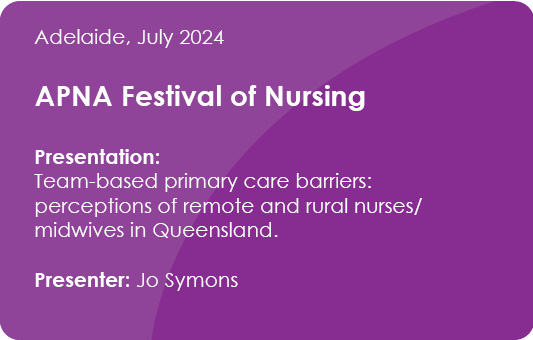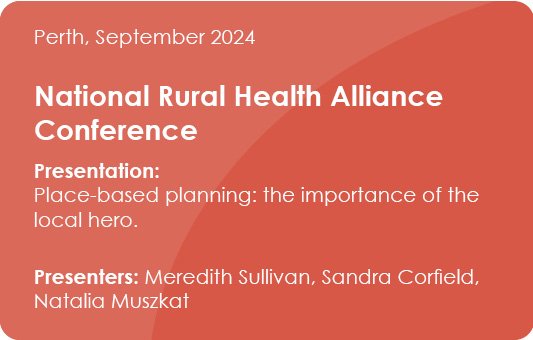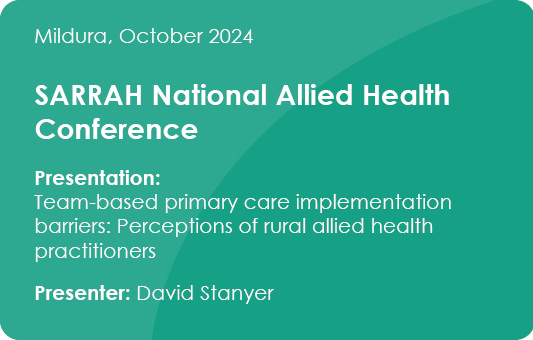KEEP IN TOUCH
(07) 3105 7800
Turrbal and Jagera Country
Level 4, 348 Edward Street
Brisbane QLD 4000
(07) 3105 7800
Turrbal and Jagera Country
Level 4, 348 Edward Street
Brisbane QLD 4000
This year, in-depth data analysis has provided valuable insights that have shaped our storytelling and discussions across forums and conferences, highlighting the experiences of the remote and rural primary health care workforce, and demonstrating the impact and value of our work in these communities.
The following presentations and discussions were made by HWQ in 2024-2025:
 |  |  |
 |  | |
RDAQ Conference, Rural Workforce Forum Breakfast
Annually HWQ sponsors the Rural Workforce Forum, which is a breakfast session of the Rural Doctors Association of Queensland (RDAQ) Conference. This year’s conference held in June 2025 discussed the findings of our annual Health Workforce Needs Assessment (HWNA) survey ‘Issue in Focus’ question which explored the wellbeing of primary care practitioners in remote and rural Queensland. For this year’s survey we received responses from over 1,000 primary care practitioners and practices.
The Issue in Focus question asked participants to rate how well they were currently doing along eight inter-related dimensions of wellbeing. Results suggested generally positive perceptions of current health and wellbeing in the rural primary care workforce.
Participants also indicated that they believed their health and wellbeing was better as compared to two years prior. This finding aligns with the Royal Australian College of General Practitioners’ (RACGP) 2024 Health of the Nation report which found that burnout among GPs has decreased to 69 percent in 2024, down from 73 percent in 2022. This suggests that the workload pressure on GPs, which has been immense over the past few years, has somewhat eased.
Medical practitioners at the Rural Workforce Forum contributed to polling and table discussions which identified the following as underpinning factors:
Reduced hours and improved work-life balance has contributed to a more sustainable and satisfying professional experience.
Reduced COVID-related stress has eased pressure on practitioners, allowing for better overall wellbeing.
A shift in the value placed on work has encouraged healthier boundaries and priorities.
A more positive outlook among practitioners may be reinforcing a cycle of improved mental health and job satisfaction.
In addition, when the survey results for medical practitioners were analysed, we found that those who had a principle role in private general practice tended to report much better wellbeing on most dimensions as compared to those whose main primary care role was within the public hospital system. So, during the Rural Workforce Forum, polling and table discussions were utilised to provide a deeper understanding of the positive aspects about private general practice settings that might contribute to better health and wellbeing. The following themes emerged:
Greater flexibility in general practice allows GPs to better set their own schedule and maintain a good work life balance with shared or distributed on-call and overtime arrangements.
Salaried GP positions can provide stability without the added pressures often associated with hospital shift work.
Rural hospital roles may involve higher acuity, unpredictable hours, and emergency responsibilities, contributing to lower wellbeing scores.
There was agreement that the most important elements to health and wellbeing in a private practice primary care setting were manageable on-call and shift work requirements, more employment flexibility, less bureaucracy and stronger patient connection in that order.
The RDAQ Conference and survey findings paint a picture of optimism amongst primary care practitioners in remote and rural Queensland and provide some potential avenues that both public and private health services could explore to encourage better health and wellbeing for their staff, particularly through providing more employment flexibility and reducing the burden of inefficient administration procedures in the workplace.
This year's HWNA survey also asked, ‘In your opinion, what are the most important factor(s) that would improve mental health and wellbeing among health practitioners in your community?’ The two most important themes that emerged were increased staffing and management and policies.
For increased staffing, some medical practitioners talked about having other medical staff to relieve the burden of hours for a better quality of life. Others wrote about increasing access to mental health professionals so that support, when required, was available. Yet others wrote about increasing the number of allied health professionals so that timely referral pathway could reduce pressure on doctors.
For management and policies, many medical practitioners wrote about the amount of paperwork required. However, others noted things such as access to leave when required to refresh, and others to more flexibility generally – things like reduced working hours, less night shifts, and support for CPD activities. Still others wrote about management being more supportive and empathic with staff members.
Pictured below, clockwise left to right: Meredith Sullivan presenting at the National Rural Heath Conference, Jo Symons presenting at the Rural Workforce Forum breakfast at the RDAQ Conference
and David Stanyer presenting at the SARRAH National Allied Health Conference.

